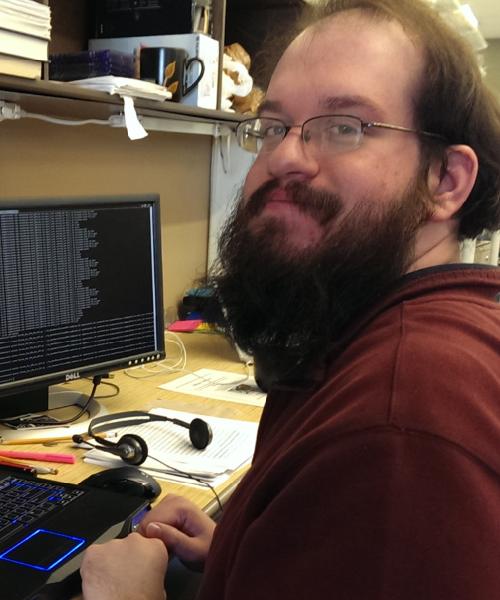NIMBioS Postdoctoral Fellow Profile: Nicholas Panchy
Q&A with Dr. Panchy
 Hometown: Asheville, North Carolina
Hometown: Asheville, North Carolina
Field of Study: Bioinformatics/Molecular Biology
What is your field and why does it inspire you? Why did you choose this field?
I started in bioinformatics because I have a background in both mathematics and biology, but I stuck with the field because of the amount of data (DNA sequences, RNA profiles, etc.) that is available to answer questions in many fields of biology, such as molecular biology, genetics, and evolution. Much of the "omics" data generated by the scientific community is underutilized, so I am not only interested in making the most of it in my own research, but also interested in training other researchers in bioinformatics and related computational biology techniques.
Describe your current research.
My current research focuses on modeling how the process of cell differentiation is regulated in mammals. In general, cell differentiation is how the cells of the body change shape and/or function. As an example, when you get a cut, your skin cells need to change so that they can move into the wound as part of the healing process, but once the wound is healed, the cells need to change back so that they don't move into a part of the body where they don't belong. By creating a model of how cell differentiation is regulated, we can both learn how the process is controlled normally and explore how mis-regulation might influence conditions like cancer.
What is the primary aim of your research? What is your primary professional goal?
In the long run, I would like to make mathematical and computational techniques that I use regularly in my research more accessible to the community of biologists at large by serving at an institution that focuses on teaching and/or providing bioinformatics/computational techniques as a service.
What is the biggest obstacle to achieving your objective(s)?
In my experience, I've seen many researchers assume that, because bioinformatics involves math or programming, it is not something they can learn. Even students who have taken bioinformatics courses that I have taught assume that they will never have more than a cursory master of the subject because they are "bad with computers." However, I think the real difficulty that researchers often have when approaching this field has more to do with unfamiliarity than the subject itself. More effort needs to be put into making bioinformatics accessible by reducing jargon and teaching skills that have immediate, direct application to the student's current research goals, even in introductory courses.
How does your work benefit society?
Although computational biology and bioinformatics will never replace bench science, they do make the scientific process faster and more efficient. Imagine if the human genome had to be assembled by hand? We would likely still be waiting for the complete sequence. With my current work modeling regulation of cell differentiation, the hope is that we can both make predictions with existing experimental data and help identify what future experiments would be most informative.
What do you like best about your work?
What I enjoy most is being able to collaborate with other researchers in a variety of fields other than my own. Being a bioinformatician, I have had the opportunity to work with computer scientists, statisticians, biochemists, geneticists, ecologists and evolutionary biologists on a variety of organisms from humans and mice to algae and bacteria. I am always excited to see what other scientists are working on.
Which professional accomplishment are you most proud of? What stands out as your crowning achievement?
I am most proud of the time I spent as a teaching assistant for the Frontiers and Techniques in Plant Science course at Cold Spring Harbor. I had the opportunity to work closely with around 30 scientists ranging from undergraduates to faculty over two years and help them to develop computational/bioinformatic skills. I've been in contact with many of them since the conclusion of the course, and it has been amazing to see how what they learned during the course impacted their research.
On the other hand, what has been your most discouraging professional moment and how did you recover? What did you learn?
Prior to coming to NIMBioS, one of the labs where I worked submitted a proposal to NSF that was rejected. Some of the feedback was neither constructive nor relevant to the proposal: our computational methods were criticized using invective rather than evidence. To be honest, I was upset over this for quite a while, but eventually the experience became a motivating factor to invest more time and effort helping others learn about how computational and mathematical methods can be used to further the study of biology.
What exciting developments lie in the future for your field?
I am very excited about next generation sequencing technology like PacBio, which will make it easier to sequence genomes and provide more accurate profiles of gene expression. In the future, I expect that PacBio and other long-read sequencing technology currently in development will greatly expand the number and variety of species for which we have genomes and "omics" data.
What do you do when you're not in the lab or out in the field?
I like to explore whatever town I am living in by picking a random direction to walk in or trying a different route when I am driving just to see what I find. I enjoy cooking and trying new kinds of foods, so this has been a fun way to find new places to eat and buy food. I also have a small snake (Ball python) so I feed and care for him. To relax, I mostly read or play video/board games with friends.
Nicholas Panchy's Postdoc page
NIMBioS
1122 Volunteer Blvd., Suite 106
University of Tennessee
Knoxville,
TN 37996-3410
PH: (865) 974-9334
FAX: (865) 974-9461
Contact NIMBioS


